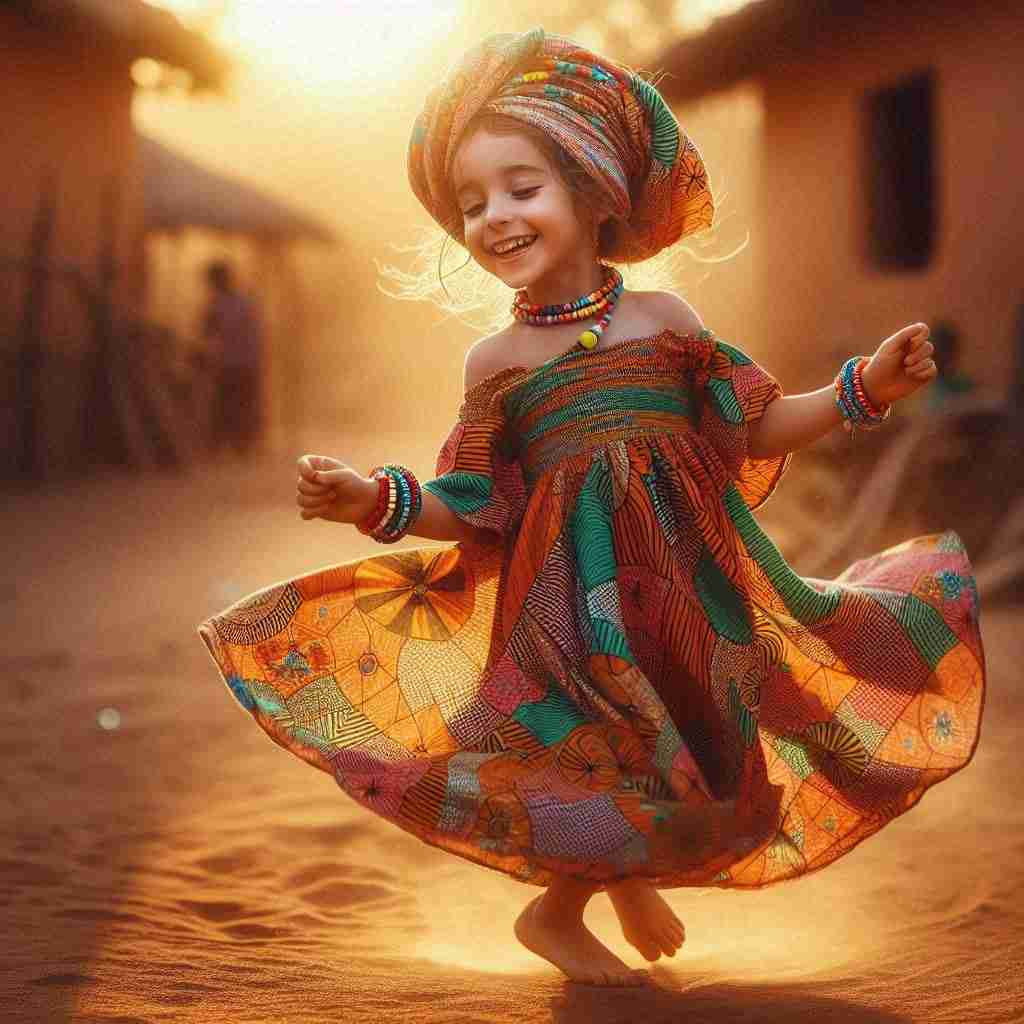Aprilena's Dance (Igbo)
Richard

Aprilena, ihe oyibo,
Jikọrọ mmadụ niile, nwee ọ joy,
Aprilena, ihe oyibo,
Dancing in the sunlight, spreading joy.
Little April, with a smile so bright,
Dressed in colours, oh what a sight,
In her wrap and head-tie, she shines,
Bringing happiness, in every line.
With beads around her neck, she twirls,
A little queen in a vibrant swirl,
Her laughter echoes, pure and free,
Aprilena, you’re a melody.
In the heart of every beat,
April's dancing feet,
Unity and love, in her eyes,
She’s the song of the skies.
Aprilena, oh sing with me,
A world of love and harmony,
Aprilena, in every way,
You brighten up our every day.
Richard's Aprilena's Dance
Introduction
In the realm of contemporary poetry, the intersection of cultural identity, familial bonds, and the celebration of innocence often yields profound artistic expressions. "Aprilena's Dance," a lyrical composition by Richard, stands as a testament to this confluence, offering a rich tapestry of imagery, language, and emotion. This analysis seeks to unravel the multifaceted layers of the poem, exploring its thematic depth, linguistic intricacies, and cultural significance. Through a close examination of its structure, diction, and symbolic elements, we will delve into the ways in which this piece not only captures the essence of a child's joyous spirit but also serves as a bridge between cultures, languages, and generations.
Cultural Fusion and Linguistic Diversity
One of the most striking aspects of "Aprilena's Dance" is its seamless integration of multiple languages, specifically English and Igbo. This linguistic fusion is not merely ornamental but serves as a fundamental pillar of the poem's thematic structure. The recurring refrain, "Aprilena, ihe oyibo, / Jikọrọ mmadụ niile, nwee ọ joy," encapsulates this bilingual approach. The term "ihe oyibo" is particularly intriguing, as it translates roughly to "white thing" or "foreign thing" in Igbo. This juxtaposition of Aprilena being described as both "ihe oyibo" and as a figure deeply rooted in African cultural symbols (such as the wrap and head-tie) creates a fascinating tension that speaks to themes of cultural hybridity and the negotiation of identity in a globalized world.
The use of Igbo in the refrain, followed immediately by English lines, creates a rhythmic pattern that mimics the dance-like quality the poem celebrates. This linguistic dance mirrors the physical dance of Aprilena, suggesting that language itself is a form of movement, a way of navigating between worlds. The phrase "Jikọrọ mmadụ niile, nwee ọ joy" translates approximately to "Bringing people together, having joy," reinforcing the theme of unity that permeates the poem.
Symbolism and Imagery
Richard employs a rich tapestry of symbols and images to paint a vivid portrait of Aprilena. The imagery is predominantly visual and kinetic, emphasizing color, light, and movement. The "wrap and head-tie" and "beads around her neck" are not merely descriptive elements but potent cultural symbols that root Aprilena in a specific tradition while simultaneously presenting her as a universal figure of joy and innocence.
The recurring motif of dance serves multiple functions within the poem. On a surface level, it captures the exuberance and physicality of childhood. However, on a deeper level, dance becomes a metaphor for cultural expression, spiritual connection, and the harmonious integration of diverse elements. The line "In the heart of every beat, / April's dancing feet" suggests a rhythm that goes beyond the audible, implying a cosmic dance that aligns Aprilena with the natural world and perhaps even spiritual realms.
Light imagery, particularly the emphasis on Aprilena "Dancing in the sunlight," reinforces themes of joy, purity, and illumination. This association with light positions Aprilena as a figure of hope and renewal, reminiscent of the month of April itself, which is often associated with spring and new beginnings in many cultures.
Structure and Form
The poem's structure is notable for its use of repetition and refrain, creating a song-like quality that reinforces its musical themes. The repeated chorus serves as an anchor, providing a rhythmic and thematic foundation around which the narrative verses are constructed. This structure mirrors traditional African song forms, where call-and-response patterns and repetitive choruses are common, further embedding the poem in a specific cultural context.
The alternation between longer narrative verses and the shorter, punchier refrain creates a dynamic rhythm that propels the poem forward. This structure also serves to emphasize key themes and phrases, particularly the bilingual elements, ensuring that they resonate with the reader long after the poem has ended.
Themes of Unity and Transcendence
At its core, "Aprilena's Dance" is a celebration of unity and the transcendent power of joy. The line "Unity and love, in her eyes" directly articulates this theme, positioning Aprilena as a symbol of harmonious coexistence. The poem suggests that through her dance—and by extension, through cultural expression and celebration—barriers can be overcome and connections forged.
The description of Aprilena as "the song of the skies" elevates her from a mere individual to a cosmic symbol, suggesting that the joy and unity she represents have universal significance. This transcendent quality is further emphasized in the final verse, where the speaker invites Aprilena to "sing with me, / A world of love and harmony." Here, the dance transforms into song, and the individual celebration becomes a call for global harmony.
The Role of Childhood and Innocence
Aprilena's youth is central to the poem's impact. Her innocence serves as a counterpoint to the complexities of cultural identity and the challenges of navigating multiple worlds. The poem suggests that there is wisdom in this innocence, a natural ability to bridge divides that adults might find insurmountable. Lines such as "Little April, with a smile so bright" and "Her laughter echoes, pure and free" emphasize the transformative power of childlike joy and spontaneity.
Moreover, the focus on a child allows the poem to touch on themes of legacy and future. Aprilena becomes not just a present source of joy but a promise of what the future could hold if her spirit of unity and celebration is embraced.
Conclusion
"Aprilena's Dance" is a masterful exploration of joy, cultural identity, and the unifying power of celebration. Through its intricate weaving of languages, vivid imagery, and carefully structured form, the poem creates a multisensory experience that resonates on emotional and intellectual levels. Richard has crafted a piece that functions simultaneously as a personal ode to a beloved niece and a broader meditation on the possibility of cultural harmony.
The poem's significance extends beyond its immediate context, offering insights into the complexities of multicultural identities and the role of art in bridging diverse worlds. By centering the narrative on a child's dance, Richard reminds us of the simple yet profound truths that often elude adults: the joy of movement, the power of a smile, and the possibility of unity in diversity.
In a world often divided by cultural, linguistic, and ideological barriers, "Aprilena's Dance" stands as a testament to the enduring power of love, innocence, and celebration to bring people together. It challenges readers to see the world through Aprilena's eyes, where differences are not obstacles but opportunities for joyous interaction. Ultimately, the poem leaves us with a hopeful vision of a world where, like Aprilena, we can all dance in the sunlight, spreading joy and fostering harmony across all boundaries.
This text was generated by AI and is for reference only. Learn more
Want to join the discussion? Reopen or create a unique username to comment. No personal details required!



Comments
No comments yet. Be the first to comment!